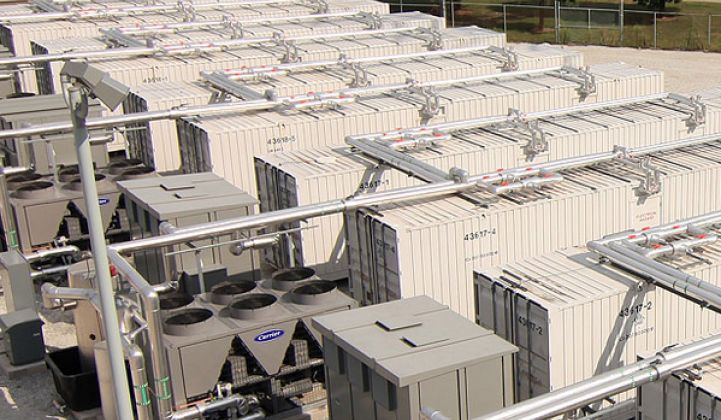The energy storage asset class puts a single label on a dizzying variety of technologies and applications. It's hard to compare a cavern full of pumped air with a lithium-ion battery, even if they perform similar functions. This makes it difficult to gauge progress across the entire industry.
The financial analysts at Lazard make it easier with their Levelized Cost of Storage Analysis, the second annual installment of which was released Thursday. They standardized costs for 10 prevailing storage technologies to show how they stack up for 10 particular use cases.
The picture that emerges is of an ecosystem of technologies rapidly trending down in cost, especially for the larger-scale projects. The old grid-scale stalwarts, pumped hydro and compressed air, still beat the newcomers on cost, but the advanced technologies are closing the gap quickly, and they can operate in many more settings.
Model improvements
Lazard's model takes data from storage manufacturers and developers to determine the levelized cost of storage for a particular use, and then compares that with the best available incumbent alternative. The model steers clear of systematically determining value, a most elusive quality that changes from place to place.
For instance, pumped hydro boasts a very low price per megawatt-hour, ranging from $152 to $198 in this report. That won't make it competitive, though, for a project in the middle of a flat desert, where there's no pumpable body of water to use. This report gives the cost and lets users apply that to their own use cases, and offers a few value snapshots at the end.
Outside of those snapshots, the authors steer clear of modeling "value stacking," the strategy employed by storage vendors when any single use doesn't make economic sense. However, readers with data on the stacked values of a storage application can compare it to the levilzed cost of storage (LCOS) to determine if it makes financial sense.
The researchers at Lazard have been tinkering away since last year to upgrade their storage model. They've narrowed the LCOS ranges, better tailored the use cases to real-world applications, divvied up the flow batteries category into the different key technologies and included costs in terms of power, not just energy.
The changes in methodology require caution in making one-to-one comparisons with the previous edition of the study, because not all of the categories mean the same things now.

Source: Lazard's Levelized Cost of Storage Analysis 2.0
Ride the cost curve
The use cases examined will be familiar to storage industry observers. In front of the meter: transmission assistance, peaker replacement, frequency regulation, distribution substation and distribution feeder. Behind the meter: microgrids, island grids, commercial and industrial systems, commercial appliance (sized smaller, not meant for grid services) and residential.
Lithium-ion costs have dropped noticeably since last year's report. For peaker plant replacement, which holds tremendous potential both for decarbonizing the grid and reducing overall capital costs, lithium-ion now ranges from $285 to $581 per megawatt-hour; last year it was $321 to $658 per megawatt-hour. That's a 12 percent drop in the median cost in one year.
Lithium-ion also fell 24 percent for the transmission use case and 11 percent for residential. Its lowest-cost use is for frequency regulation, where the minimum cost fell from $211 per megawatt-hour last year to $190 per megawatt-hour.
The cost ranges for flow batteries got more expensive since last year but also tightened, reflecting a more precise modeling of reality.
The range for flow batteries in peaker displacement and transmission last year exceeded $600 per megawatt-hour. This year that range was considerably reduced; zinc-bromine flow batteries have the most precise range, $434 to $549 per megawatt-hour for transmission and $448 to $563 for peaker replacement. That reflects the ongoing maturation of this technology and the increase in available data on it.

Source: Lazard's Levelized Cost of Storage Analysis 2.0
Lazard and partner Enovation predict capital cost declines will continue across the board in the next five years, with the strongest declines in lead acid batteries, lithium-ion energy applications, sodium and long-duration flywheels. The vanadium flow batteries clock in with an impressive 24 percent average predicted cost decline as well.
Overall, the industry still has a lot of work to do. There's a clear trend of the costs being lower across the board for bigger-scale projects: median costs for transmission projects are lower than distribution projects, which are lower than residential. That's to be expected given economies of scale, but it creates an ongoing challenge for all of those residential vendors trying to convince homeowners to buy.
That's not all bad for residential suppliers, though. Cost parity with incumbent technologies can be reached more quickly on the grid-scale side, and the supply chain work there should also lower capital costs for smaller storage applications. In other words, residential storage benefits from the industry's overall success.



